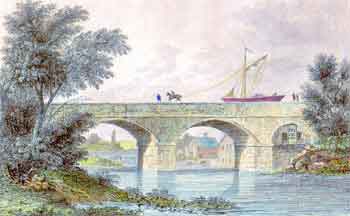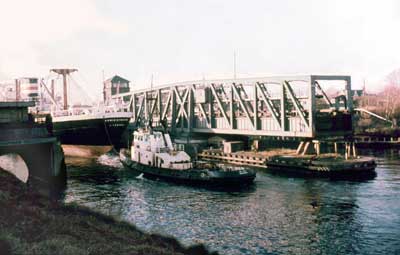
Constructed in 1761 by James Brindley, this stone aqueduct was required to carry the Bridgewater Canal over the river Irwell at Barton-upon-Irwell. This canal is now usually known as the Stretford and Leigh Branch of the Bridgewater Canal.

The Bridgewater Canal was constructed by the famous canal triumvirate of Francis Egerton, third Duke of Bridgewater, the promoter, John Gilbert, the Duke's agent, and James Brindley, the surveyor and engineer. The purpose of this canal was to transport coal to Manchester and Salford and so reduce its cost. The supply of water for the canal was from the Duke's coal mines at Worsley and in this way the mines were drained as well. Thus, three problems were solved at once.
The aqueduct was about 200 yards long by 12 yards wide and it had three arches, the centre one having a span of 63 feet. It carried the canal at a height of 39 feet above the river Irwell. It was the major wonder of its day and some said that it was impossible to construct. It is believed to be the origin of the well-known saying, 'And pigs might fly'. The full saying being, 'And pigs might fly when waters meet in Market Street.' In the event, doubters were proved wrong and waters did meet at Castlefield, close to Market Street in the heart of Manchester. As soon as it was opened, people flocked to witness the spectacle of boats sailing high above other boats on the river Irwell, which then formed part of the ancient Mersey and Irwell Navigation.
The decision to build Manchester Ship Canal was taken in the 1880s and it was decided to use the course of the river Irwell at Barton as part of the navigation channel. This meant that Brindley's stone aqueduct had to be demolished although it remained open until the replacement swing aqueduct was completed.
Manchester Ship Canal opened for trade on the 1 Jan 1894 and was formally opened by Queen Victoria on the 21 May 1894.
Sir Edward Leader Williams (1828-1910) designed the swing aqueduct and it holds 800 tons of water and has a gross weight of 1,450 tons. It is swung, full of water, to allow the passage of boats along the Manchester Ship Canal. Because it is swung full of water, it is sealed at both ends with hydraulically operated gates and the ends of the Bridgewater Canal are sealed in a similar manner.
As built, the accumulator tower provided the hydraulic power needed and it contained a weight-loaded accumulator, which was literally a large diameter cylinder with a piston inside it having a very heavy weight bearing down on it. The purpose of this was to supply smooth hydraulic power and to balancee fluctuations in demand for the supply of power. After use, an hydraulic pump was used to raise the piston back to the top of its stroke. Sir William George Armstrong (1810-1900) developed the weight-loaded accumulator.
Barton Swing Aqueduct


View of the aqueduct in the closed position looking towards Manchester from the north bank (Barton-upon-Irwell/Patricroft/Eccles side). Boats on the Bridgewater Canal can then cross over the Manchester Ship Canal.
A surviving abutment of Brindley's aqueduct is on the left and the accumulator tower used to operate the aqueduct is on the right.
It was reported that the aqueduct was swung for the first time in November 1893.
View of the aqueduct in the open position looking towards Barton Locks and Irlam from the south bank (Trafford Park/Dumplington side). Ships on the Manchester Ship Canal can then pass the Bridgewater Canal.
Culverts were constructed in 1892 to divert the river Irwell while the central island, swing aqueduct and adjoining Barton Bridge (swing bridge) were built.
Barton Bridge connects Barton Road on the north bank to Redclyffe Road on the south bank.
Listing
Barton Swing Aqueduct is listed Grade II*, List Entry No. 1356522.
The Bridgewater Canal’s Barton Aqueduct embankment and retaining walls is a Scheduled Monument, List Entry No. 1470478.
This consists of the remaining section of James Brindley’s stone aqueduct (1780/61) containing the raised,
embanked section of the Bridgewater Canal that extended between the bridging sections across Barton Lane and the River Irwell.
It incorporates strengthening work that enlarged the embankment in 1822/24, as well as a section of the original Bridgewater Canal that was infilled in 1894
when it was realigned eastwards owing to the construction of the Manchester Ship Canal.